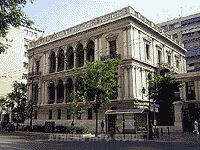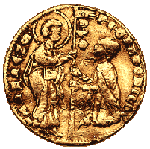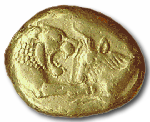
Numismatic Museum
Iliou Melathron
The
Numismatic Museum is situated on Panepistimiou (Eleftheriou Venizelou)
Street close to Syntagma Square. It is housed in the Iliou Melathron
(Palace of Ilion), the house of the famous German archaeologist
Heinrich Schliemann (1822-1890) who excavated Troy (ancient Ilion)
and Mycenae.
The
museum was founded in 1834 and displays important collections
of coins, molybdobulls (coins made of molten metal), medals and
precious stones from ancient Greece, Rome, Byzantium, the Orient,
medieval and modern Europe, United States and modern Greece. The
museum is unique in Greece and one of the most important of its
kind in the world.

Heinrich
Schliemann (1822-1890)
Throughout
his adventurous life, the German Heinrich Schliemann
gained  great
wealth as a businessman. When he was forty year old,
he turned to archaeology and set out to fulfil his
life dream, the discovery of Homer’s world. great
wealth as a businessman. When he was forty year old,
he turned to archaeology and set out to fulfil his
life dream, the discovery of Homer’s world.
He
was the pioneer of prehistoric archaeology and he
proved the existence of the Mycenaen world. His excavations
at Troy, Mycenae, Orchomenos, Tiryns and Ithaca, caused
great sensation and admiration but also controversy.
His
love for Greece and its culture, as well as his marriage
to Sophia Engastromenou (Kastrioti) connected him
closely to Greece, which became his second homeland. |
Before
the collections were permanently housed in Schliemann’s
house, they were kept at the University of Athens, the Academy
and the National Archaeological Museum. During the German rule,
they were safely kept in the vaults of the Bank of Greece.
The
Iliou Melathron was built between 1878 and 1880 by the German
architect Ernst Ziller. It shows the influence of the buildings
of the Italian Renaissance, adapted however to late 19th century
neoclassicism. It is considered to be one of the Athens’
most characteristic neoclassical buildings and one of Ziller’s
most important works.
 Ernst
Ziller (1837-1923) Ernst
Ziller (1837-1923)
Ziller
was one of the most important architects of the 19th century.
He was born in the German town of Dresden and came to
Greece in 1862 as an assistant of Theophilus Hansen  for
the construction of the Academy of Athens. He remained
in Greece for the rest of his life. for
the construction of the Academy of Athens. He remained
in Greece for the rest of his life.
Ernst
Ziller designed churches, public buildings, monuments,
graves, mansions and houses in Athens and other cities.
He frequently combined elements from Roman and Renaissance
architecture with various Greek styles. His great reputation
meant that buildings designed by other architects were
often attributed to him.
Among
his most significant works are the National Theatre (1882-1900),
the Presidential Mansion (1891-1897), the Military Academy
or Evelpidon School (1889-1894) and the church of Saint
Lucas (Agios Loukas) on Patission (28 October) Street.
His most typical work, however, is the house of Heinrich
Schliemann, also known as Iliou Melathron.
|
The
building has a garden on three of its sides and its ground plan
is almost a perfect square. Its façade, with arched verandas
and Ionic colonnades, makes it one of the most impressive houses
in Athens. Inside, the walls and ceilings have been decorated
with paintings by the Slovenian artist Yuri Subic. They are mostly
copies of the mural paintings in Pompei. The mosaic floors made
by Italian craftsmen show various geometric patterns as well as
objects uncovered by Schliemann in the excavations at Troy and
Mycenae. The house was officially opened on 30 January 1881.
 The
Iliou Melathron was purchased by the Greek state in 1927 and for
a while it was used to house the Supreme Court (Areos Pagos).
It was renovated in 1984 and in the same year, the Numismatic
Museum was transferred here. In 1998, the museum’s permanent
exhibition was mounted on the first floor where the Schliemann
family used to socialize. The transfer of the museum’s entire
collection and functions was completed in the beginning of 2003. The
Iliou Melathron was purchased by the Greek state in 1927 and for
a while it was used to house the Supreme Court (Areos Pagos).
It was renovated in 1984 and in the same year, the Numismatic
Museum was transferred here. In 1998, the museum’s permanent
exhibition was mounted on the first floor where the Schliemann
family used to socialize. The transfer of the museum’s entire
collection and functions was completed in the beginning of 2003.
The
main parts of the museum’s collections have been donated
by a number of wealthy Greeks. The most significant collections
in quantity and variety are those donated by the Zosimades Brothers
(1857), Giannis Dimitriou (1892) and Grigorios Empedoklis (1953).
The first of these collections included over 18.000 coins and
medals, the other two around 10.000 and 7.800 coins respectively.
 The
exhibition starts in the old reception rooms with information
on the building and its architect, while there are also important
highlights of Schliemann’s work and his coin collection.
In the reception hall, the Esperides hall, visitors can learn
about the use of various metals for transactions, the invention
and wide use of coins, metals and methods for the cutting of ancient
coins, as well as treasures. The
exhibition starts in the old reception rooms with information
on the building and its architect, while there are also important
highlights of Schliemann’s work and his coin collection.
In the reception hall, the Esperides hall, visitors can learn
about the use of various metals for transactions, the invention
and wide use of coins, metals and methods for the cutting of ancient
coins, as well as treasures.
In
the study room, or Literary Salon, there are several series of
“strong” ancient coins like those of Athens and the
Kingdom of Alexander the Great. In the adjacent room, the coins
on display highlight the various images that they carry. In the
space where the dining rooms used to be, parts of the donated
collections are on display. Finally, there is a room with photographic
and archival material. Once the restorations works on the wall
paintings of the second floor have been completed, there will
be an exhibition of Roman, Byzantine, medieval and more recent
coins and items.
 Opening hours and admission
Opening hours and admission
 Iliou Melathron, 12, on
Panepistimiou (Eleftheriou Venizelou) Street
Iliou Melathron, 12, on
Panepistimiou (Eleftheriou Venizelou) Street
 Syntagma
Syntagma 

|

